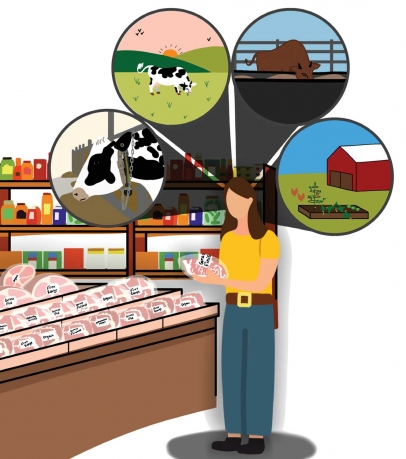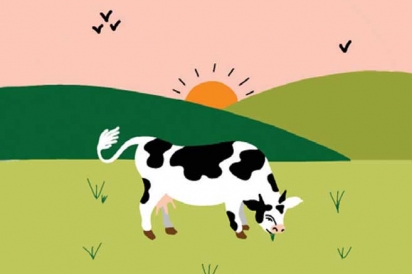Don’t Enable Vague Labels: How to Know if Your Meat is Actually Sustainable
THE PHRASE FARM-TO-TABLE is referenced a lot nowadays, but many of us are still, on average, dispiritingly removed from where and how our food originates. We often buy it in brightly lit grocery aisles that at times resemble hospital corridors. At least, by now, it’s clear that not all farms or ranches are created equal, nor are their industrial offshoots, factory farms. This makes for significant disparity in the quality of life and death for the creatures involved. And people have long noticed.
With the popularity of books like the Omnivore’s Dilemma and Eating Animals seeded in the social psyche, and a growing demand for more organic meat and produce (as far back as the 1960s), the market and persuaded farmers are answering the call from consumers who broadly have three aims: to eat animals that were treated respectfully, were themselves healthier (and so healthier to consume), and were produced using more environmentally responsible methods.
An umbrella term for these types of concerns, managed into a purchasable product, is sustainable meat. There are also subterms that define production influenced by this school of thought that have been delineated by the U.S. Department of Agriculture’s marketing branch, the Agricultural Marketing Service (AMS):
Grass Fed: Defined by the USDA in 2006: “Grass and forage shall be the feed source consumed for the lifetime of the ruminant animal, with the exception of milk consumed prior to weaning. The diet shall be derived solely from forage consisting of grass (annual and perennial), forbs (e.g., legumes, Brassica), browse, or cereal grain crops in the vegetative (pre-grain) state.” Although the definition still appears on their website, the USDA’s AMS no longer evaluates grass-fed labels before they’re in stores. That work has been turned over to a different wing of the department: the Food Safety and Inspection Service (FSIS). Producers must now submit a proposal and supporting documentation to FSIS to obtain the label. If consumers want more assurance that grass-fed claims are truthful, they can look for a third-party certification label, such as one from the work of the Agricultural Marketing Service and the Food Safety and Inspection Service.
Grass Finished: The USDA doesn’t have a definition for this label, which entered the market because grass fed doesn’t guarantee that the cow wasn’t given grain in the last months of its life to expedite its final slaughter weight.
Free Range: For any meat or poultry food product to be labeled free range, producers must provide a brief description of the housing conditions to the USDA’s Labeling Program and Delivery Division, which will review it to ensure animals have “continuous, free access to the out-of-doors for over 51% of the animals’ lives, i.e., through their normal growing cycle.” Keep in mind, this does not regulate population density or require that the chicken actually goes outside, just that access is available for the majority of its life.
Organic: “Regulations require that animals are raised in living conditions accommodating their natural behaviors (like the ability to graze on pasture), fed 100% organic feed and forage, and not administered antibiotics or hormones.”
With all of these labels, consumers pay more. Is it worth it? Let’s take a look at sustainable meat. The assertion goes that grass-fed beef is less harmful to the environment. Advocates suggest that adding helpful nutrients to the soil through manure, which promotes soil health and biodiversity, will cause plant life to teem and trap carbon dioxide. To help support a deepening root system, farmers also don’t plow, which tends to reduce soil erosion later on, something that would further damage its nutrient levels and its capacity to positively alter CO2 levels. These practices are known as regenerative agriculture.
When these practices are followed, grazing cattle put on weight slower than their grain-fed counterparts and therefore live longer lives, releasing a larger sum of methane in the atmosphere. Add to that the understanding that anything on nature’s terms is a delicate balance, particularly the calculation and management of animal population density. Get that wrong, and the prospects of sequestration and soil enhancement can be a wash. Because of this, the animal’s grazing patterns must be carefully managed. Think of the patterns as grazing zones: They can’t spend too much time in any one zone or they’ll create havoc in the soil instead of harmony. That’s why a good deal of grass-fed beef, particularly ground beef, comes from countries other than the United States, where grazing land is more abundant. NPR reported in a 2019 article that “75% to 80% of grass-fed beef sold in the U.S. is grown abroad, from Australia, New Zealand and parts of South America, according to a 2017 report from the Stone Barns Center for Food and Agriculture.” The article went on to say, “By law, if meat is ‘processed,’ or passes through a USDA-inspected plant (a requirement for all imported beef ), it can be labeled as a product of the U.S.”
Still, a high-quality meat that doesn’t introduce more environmental costs to society is possible. Farms around the country have risen to the occasion, speaking back to our stressed earth through the eloquence of symbiosis.
Les Roggenbuck, owner of East River Organic Farm in Oxford and the farmer collaborative Order Up Organics, made the move to organic farming back in 1994.
“Regenerative agriculture was part of that switch, including more cover cropping, more diverse crop rotation and a greater focus on soil building, rather than just yields,” says Roggenbuck, adding that at the time few customers knew what it meant. They do now, and some inquire about his practices.
“A lot of our farmers market customers want to know how we’re raising the animals and growing the vegetables and the chickens that lay eggs, are they out on green pastures or are they in cages?”
Roggenbuck’s animals—about 40 head of cattle, 25 sheep and 200 chickens—are organic practices at his 75-acre farm and on another 55 acres he leases. Operating sustainably is important to Roggenbuck, both financially and ethically.
“Permaculture is another thing we’re integrating on the farm, which we’ve slowly gotten to know more about,” says Roggenbuck. Last spring he and his wife, Elizabeth, installed Megaera’s Garden, named for their daughter, based on a permaculture design by Sweden-based regenerative agriculture expert Richard Perkins.
In Ann Arbor, David and Anya Cobler of Sabbath Farm work hard to ensure that their animals only have “one bad day” in their whole lives. Sabbath’s Dexter-breed cows are grass fed and finished and currently roam 11 acres divided into seven sections. They are rotated every two days to make sure their manure and hoof traffic are providing optimal support to the soil. David Cobler emphasizes the stewardship of this process and has been connected to grant funding through the National Resources Conservation Service of the USDA, which helps farmers implement sustainable practices. With this funding, Cobler will build more watering stations and do some reseeding of his pastures.
His heritage pork is pasture raised and both the hogs and the chickens eat local feed. Cobler credits his wife for the farm’s regenerative approach. She was the first to discuss the principles with David, after reading Joel Salatin’s book The Marvelous Pigness of Pigs.
The delivery system of the grocery store has so localized our weekly wants and needs for food, but maybe shopping for food was never meant to be quite so easy. How it differs from the time investment many of us willingly put into picking out a single item of clothing, for example. The topic of sustainable meat is not as much of an “is it or isn’t” quandary as it is a question of how to manage our expectations so convenient consumption, for its own sake, isn’t all that matters.
Learn more about Order Up Organic at localline.ca/order-up-organic.
For more information about Sabbath Farm, visit Sabbath.Farm.
Hanna Guido is a Detroit-based writer and editor.






